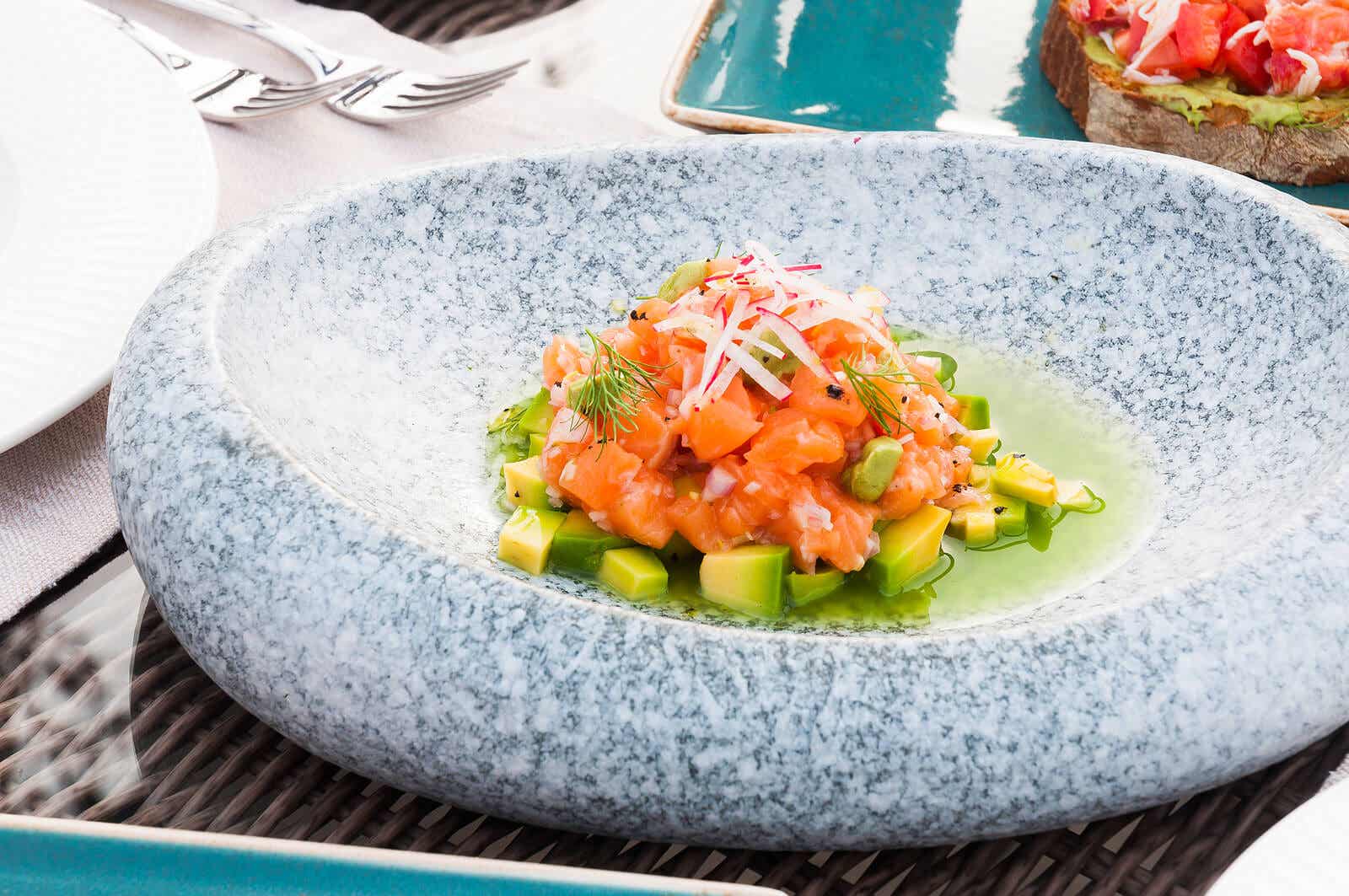Recipes to Reduce Menstrual Pain


Written and verified by the nutritionist Silvia Zaragoza
Dysmenorrhea or menstrual pain occurs in 60-70 percent of women throughout their childbearing years. Although we’ve come to assume that it’s normal, this pain has multiple causes and there are different ways to reduce it. Food’s one of them, so we’ll suggest some recipes to reduce menstrual pain.
Below, you’ll learn about the beneficial nutrients when it comes to combating menstrual pain in the most effective way. Keep reading!
Food allies to reduce menstrual pain
Although there are few studies on the subject, we do have systematic reviews that indicate that diet is a causal factor in dysmenorrhea. This pain is produced by increased levels of progesterone and the secretion of pro-inflammatory substances. This causes the uterus to contract and less blood reaches it.
On the one hand, we know that foods rich in omega-3 fatty acids, such as oily fish, nuts, seeds, and olive oil are all anti-inflammatory. When we digest them, they stimulate the formation of substances that inhibit the secretion of cytokines responsible for swelling and pain.

Other important nutrients are antioxidants such as vitamin E (olive oil and nuts), zinc (fish and seafood), vitamin A (red, orange, and yellow vegetables). It’s even been observed that girls with low blood levels of vitamin D (<30ng/ml) have more severe pain.
It’s also advisable to boost sources of calcium, as its absorption is lower. Calcium’s present in cruciferous vegetables such as broccoli, cauliflower, Brussels sprouts, alongside beans, almonds, sesame seeds, and dairy products.
Recipes to reduce menstrual pain
Vegetable Panache with tahini and lemon vinaigrette
Ingredients
- 1 head of broccoli
- 2 red peppers
- 4 medium carrots
- 1 ear of corn
- Olive oil
For the vinaigrette:
- 1 tablespoon of virgin olive oil
- 2 tablespoons of toasted tahini
- 3 tablespoons of lemon juice
- Salt
Preparation
First, wash all the vegetables with water and dry them with paper towel to remove any remaining soil. Next, remove the seeds from the peppers and the leaves from the carrots. Cut the broccoli into small spears (save the stem for another occasion) and chop the carrots into slices.
Then, put oil on a baking tray and place all the vegetables on top. Roast them in a preheated oven at 392 ºF for 30-40 minutes. Before removing them, check that they’re well done by pricking them with a knife. You can serve them with beans or roasted chickpeas.
While the vegetables are cooking, prepare the vinaigrette by mixing all the ingredients in a bowl with a whisk.
Salmon, avocado, and tomato tartar
Ingredients
- 10 ounces of fresh salmon
- 1 avocado
- 1 medium tomato
- Sesame seeds
- 1.35 fluid ounces of virgin olive oil
- 1.35 fluid ounces of lemon juice
- Salt
- Pepper

Preparation
First, remove the skin and bones from the salmon. Cut it into small cubes of the same size. Next, wash the tomato and remove the seeds. Dice it on the board. Mix with the salmon in a bowl and set aside. Next, prepare the vinaigrette by mixing the oil with the lemon, salt, and pepper.
Finally, peel the avocado, remove the pit, and cut it into cubes. Add it to the bowl to mix with the rest of the ingredients. Pour the vinaigrette on top so that all the ingredients are impregnated and to prevent the avocado from oxidizing. Garnish with a few sesame seeds.
Red fruits and peach aspic
This is a gelatinous and cold preparation based on meat, fish, vegetables, or fruits that’s ideal to consume in summer.
Ingredients
- 10 fluid ounces of water
- 0.10 ounces of agar-agar powder
- 10.5 ounces of strawberries
- 10.5 ounces of fresh blueberries
- 2 kiwis
- 1 peach
- Mint leaves
Preparation
First of all, wash the berries and dry them well. Then peel the peach and the kiwis. Cut all the fruit into cubes of the same size and mix them in a bowl. Place them in a rectangular or round mold. Then wash the mint leaves, chop them, and mix them with the fruit.
Finally, bring the water to a boil in a saucepan. As soon as it boils, add the agar-agar and stir to dilute it. Leave it for three minutes. Make sure there are no lumps or you’ll have to strain it. Finally, pour the water over the fruit and put it in the refrigerator for at least 12 hours.
Food and menstrual cramps
As you can see, food can help you combat these discomforts during menstruation, along with other measures such as emotional management, relaxation, putting a warm cushion on the painful area, etc. So, what are you waiting for to try these simple recipes to reduce menstrual pain?
Dysmenorrhea or menstrual pain occurs in 60-70 percent of women throughout their childbearing years. Although we’ve come to assume that it’s normal, this pain has multiple causes and there are different ways to reduce it. Food’s one of them, so we’ll suggest some recipes to reduce menstrual pain.
Below, you’ll learn about the beneficial nutrients when it comes to combating menstrual pain in the most effective way. Keep reading!
Food allies to reduce menstrual pain
Although there are few studies on the subject, we do have systematic reviews that indicate that diet is a causal factor in dysmenorrhea. This pain is produced by increased levels of progesterone and the secretion of pro-inflammatory substances. This causes the uterus to contract and less blood reaches it.
On the one hand, we know that foods rich in omega-3 fatty acids, such as oily fish, nuts, seeds, and olive oil are all anti-inflammatory. When we digest them, they stimulate the formation of substances that inhibit the secretion of cytokines responsible for swelling and pain.

Other important nutrients are antioxidants such as vitamin E (olive oil and nuts), zinc (fish and seafood), vitamin A (red, orange, and yellow vegetables). It’s even been observed that girls with low blood levels of vitamin D (<30ng/ml) have more severe pain.
It’s also advisable to boost sources of calcium, as its absorption is lower. Calcium’s present in cruciferous vegetables such as broccoli, cauliflower, Brussels sprouts, alongside beans, almonds, sesame seeds, and dairy products.
Recipes to reduce menstrual pain
Vegetable Panache with tahini and lemon vinaigrette
Ingredients
- 1 head of broccoli
- 2 red peppers
- 4 medium carrots
- 1 ear of corn
- Olive oil
For the vinaigrette:
- 1 tablespoon of virgin olive oil
- 2 tablespoons of toasted tahini
- 3 tablespoons of lemon juice
- Salt
Preparation
First, wash all the vegetables with water and dry them with paper towel to remove any remaining soil. Next, remove the seeds from the peppers and the leaves from the carrots. Cut the broccoli into small spears (save the stem for another occasion) and chop the carrots into slices.
Then, put oil on a baking tray and place all the vegetables on top. Roast them in a preheated oven at 392 ºF for 30-40 minutes. Before removing them, check that they’re well done by pricking them with a knife. You can serve them with beans or roasted chickpeas.
While the vegetables are cooking, prepare the vinaigrette by mixing all the ingredients in a bowl with a whisk.
Salmon, avocado, and tomato tartar
Ingredients
- 10 ounces of fresh salmon
- 1 avocado
- 1 medium tomato
- Sesame seeds
- 1.35 fluid ounces of virgin olive oil
- 1.35 fluid ounces of lemon juice
- Salt
- Pepper

Preparation
First, remove the skin and bones from the salmon. Cut it into small cubes of the same size. Next, wash the tomato and remove the seeds. Dice it on the board. Mix with the salmon in a bowl and set aside. Next, prepare the vinaigrette by mixing the oil with the lemon, salt, and pepper.
Finally, peel the avocado, remove the pit, and cut it into cubes. Add it to the bowl to mix with the rest of the ingredients. Pour the vinaigrette on top so that all the ingredients are impregnated and to prevent the avocado from oxidizing. Garnish with a few sesame seeds.
Red fruits and peach aspic
This is a gelatinous and cold preparation based on meat, fish, vegetables, or fruits that’s ideal to consume in summer.
Ingredients
- 10 fluid ounces of water
- 0.10 ounces of agar-agar powder
- 10.5 ounces of strawberries
- 10.5 ounces of fresh blueberries
- 2 kiwis
- 1 peach
- Mint leaves
Preparation
First of all, wash the berries and dry them well. Then peel the peach and the kiwis. Cut all the fruit into cubes of the same size and mix them in a bowl. Place them in a rectangular or round mold. Then wash the mint leaves, chop them, and mix them with the fruit.
Finally, bring the water to a boil in a saucepan. As soon as it boils, add the agar-agar and stir to dilute it. Leave it for three minutes. Make sure there are no lumps or you’ll have to strain it. Finally, pour the water over the fruit and put it in the refrigerator for at least 12 hours.
Food and menstrual cramps
As you can see, food can help you combat these discomforts during menstruation, along with other measures such as emotional management, relaxation, putting a warm cushion on the painful area, etc. So, what are you waiting for to try these simple recipes to reduce menstrual pain?
All cited sources were thoroughly reviewed by our team to ensure their quality, reliability, currency, and validity. The bibliography of this article was considered reliable and of academic or scientific accuracy.
- Najafi, N; Khalkhali, H; Moghaddam Tabrizi, F; Zarrin, R (2018) Major Dietary Patterns in Relation to Menstrual Pain: A Nested Case Control Study. BMC Womens Health, 18(1): 69.
- Onieva-Zafra, M D; Fernández-Martínez, E; Abreu-Sánchez, A; Iglesias-López, M T; García-Padilla, F M; Pedregal-González, M et al (2020) Relationship Between Diet, Menstrual Pain and Other Menstrual Characteristics Among Spanish Students. Nutrients, 12(6): 1759.
- Bajalan, Z; Alimoradi, Z; Moafi, F (2019) Nutrition as a Potential Factor of Primary Dysmenorrhea: A Systematic Review of Observational Studies. Gynecol Obstet Invest, 84(3): 209-24.
- Aydin Kartal, Y; Yilmaz Akyuz, E (2018) The Effect of Diet on Primary Dysmenorrhea in University Students: A Randomized Controlled Clinical Trial. Pak J Med Sci, 34(6): 1478-82.
- Ghare Naz, M S; Kiani, Z; Rashidi Fakari, F; Ghasemi, V; Abed, M; Ozgoli, G (2020) The Effect of Micronutrients on Pain Management of Primary Dysmenorrhea: A Systematic Review and Meta-Analysis. J Caring Sci, 9(1): 47-56.
This text is provided for informational purposes only and does not replace consultation with a professional. If in doubt, consult your specialist.








